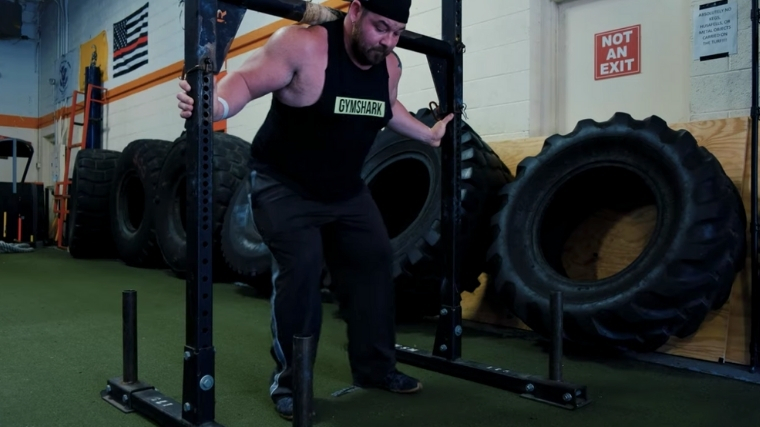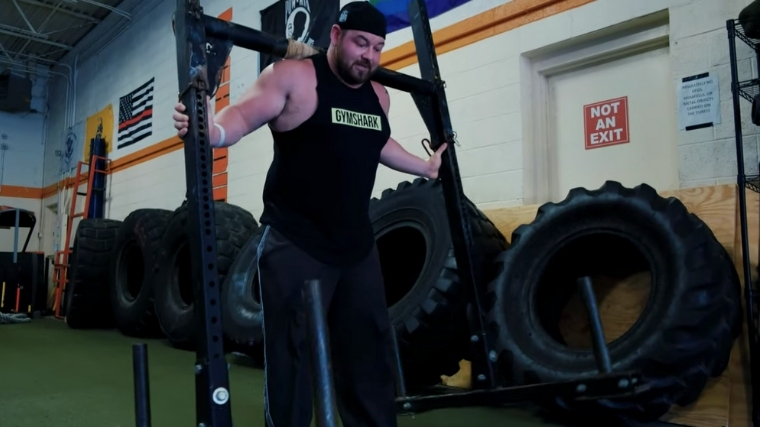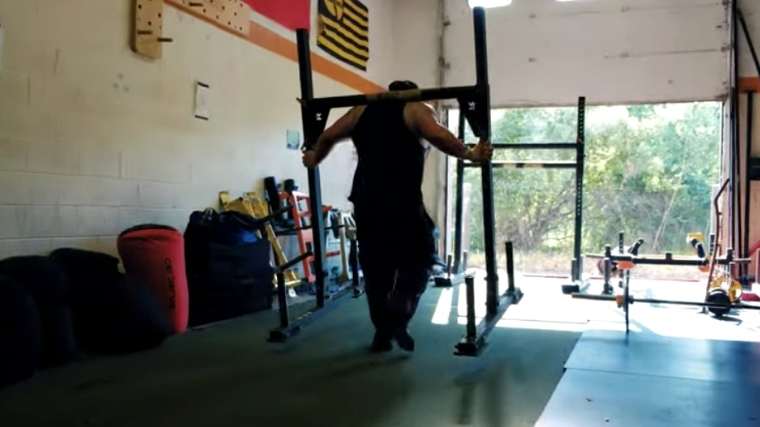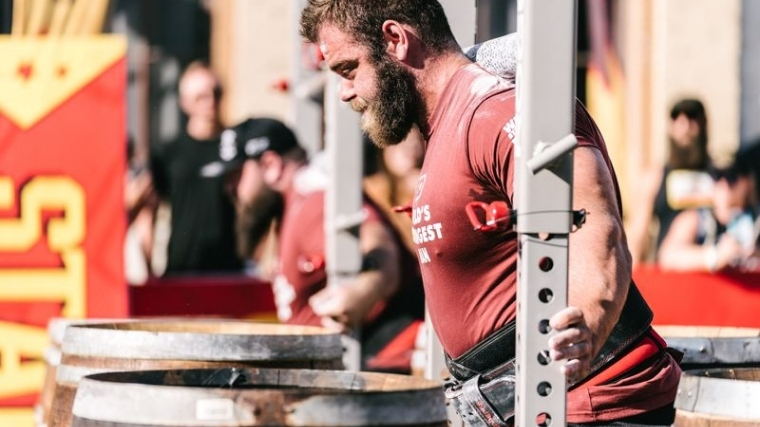The yoke walk is a popular strongman event that has the athlete support a yoke, loaded with lots of weight, on his or her back, and then run with it for time. It’s incredibly simple to do but requires a lot of core strength, stability, and coordination. Try a set of yoke walks, and you’ll learn real quick that it’s a true test of strength and conditioning that anyone from any discipline can benefit from.
CrossFit even debuted the yoke at the 2015 CrossFit Games, signaling its growing appeal and applicability to all athletes. Want to lean out? Light yoke walks will help you shred up. Looking to build muscle? Supporting hundreds of pounds on your frame, engaging nearly every muscle in your body, won’t hurt. And if you’re an aspiring strongman, the yoke walk is quite literally an event that you need to master.
But first, check out the info below and learn all you can about the yoke walk.
- How to Do the Yoke Walk
- Benefits of the Yoke Walk
- Muscles Worked by the Yoke Walk
- Who Should Do the Yoke Walk
- Yoke Walk Sets, Reps, and Programming Recommendations
- Yoke Walk Variations
- Yoke Walk Alternatives
- Frequently Asked Questions
How to Do the Yoke Walk
Below is a step-by-step guide on how to perform the yoke walk using a yoke. Note, you can also do yoke walks with a yoke attachment with some squat racks as well.
Step 1 — Get Under the Yoke

First, position the yoke so that you’re in a quarter squat position when you get under the bar.
You need enough clearance between the bottom of the yoke and floor, so it doesn’t catch during your run.
Now drive your traps into the bar and grab either side of the yoke with your hands. Your upper back should be tight. Keep your elbow positioned up and out, so the traps create more of a shelf.
Form Tip: Athletes should brace their torso by drawing in and contracting the abdominal musculature.
Step 2 — Stand Up

Brace your core and drive through your feet to stand up with the weight. The yoke will swing, so it’s important to stabilize the load before moving with it — otherwise, you’ll be too off-balance, or the yoke may crash into the floor.
Form Tip: Due to the larger diameter of the cross member, balance and stability are key. If the chest is brought too upright, any excessive forward-leaning, then the yoke will slip off the upper back’s shelf.
Step 3 — Take Small, Quick Steps

Alright, it’s time to get moving. Start by taking small, choppy steps. Slowly build up speed by increasing your steps, not lengthening your stride. Shorter steps equal more balance and stability.
Form Tip: If long, pronounced steps are used, an athlete’s torso and hip stability can be compromised, resulting in losing coordination, a dropped yoke, and wasted energy.
Benefits of the Yoke Walk
Any exercise that loads you up with lots of weight and has you take a walk is going to reap some serious benefits. Here are three worth shouting out.
Builds a Very Strong Back
During the initial Yoke lift, the lower back and muscles in the torso are highly active. They are needed to maintain proper upright positioning and support the spine during the initial lift-off phase.
Since the yoke is stressing your body for the duration of the walk, all of the muscles in your back (and elsewhere) are essentially engaged for the entire movement. This is different from a movement like a biceps curl, which systematically engages and then disengages the target muscle.
Increases Maximal Strength & Neuromuscular Adaptations
The constant tension put on a person with a yoke creates overall muscular activation, and the nervous system stimulus will function at a very high level. By training at maximal loads, the body becomes used to the impact and “feel” of weight resting on the nervous and skeletal muscular systems. This makes feeling weight on various lifts such as squats feel easier and lighter when they are held. In short, it can act as an overload of stimulus.
Can Increase Resting Metabolic Rate
Another big benefit of the yoke walk is its impact on metabolic rate (energy expenditure). Due to the full-body muscular activation of the yoke walk, the energy demand on the body is much higher. You are, after all, essentially sprinting with hundreds of pounds on your back.
You can see increases in resting metabolic rate throughout a workout and sometimes after doing walks, positively affecting overall body composition.
Muscles Worked By the Yoke Walk
The yoke walk is a true total body exercise, engaging your upper body, lower body, and core.
Below are some of the main muscle groups involved in the support and movement phases of the yoke walk. That said, please note that almost every single muscle in the body contracts maximally during heavily loaded yoke walks, which is exactly why they are such an effective and worthwhile exercise.
Upper Back, Traps, and Erectors
The Yoke walk has been shown to have significant muscle activation of the erectors and upper back musculature, especially during the initial lift-off phase of the walk. This backloaded movement forces a lifter to create high amounts of tension and stability throughout the spine and upper back while maintaining it isometrically during the walk.
Quads, Glutes, and Calves
The quads, glutes, and calves are very active in that they must work to support the load of the Yoke while also performing ankle, knee, and hip flexion and extension during the walking movement. While these degrees of motion are not as much as in a full squat, lunge, or deadlift (due to small, short, choppy steps), this is still a very stressful movement (in a productive way) for the lower body.
Oliques, Abdominals, and Transverse Obliques (Core)
The core, specifically the abdominals, obliques, and transverse obliques, all work to support the spine and lifter during the loaded walk. Inability to produce core stability during the Yoke walk could result in injury. Due to the heavily loaded walk, the abdominals are isometrically contracted to resist movement and rotation at the spine and support the pelvis and spine during the loaded walk.
Who Should Do the Yoke Walk
Anyone and everyone. Here are some reasons why specific strength athletes may want to consider setting up under a loaded yoke.
Strength and Power Athletes
- Strongman and Powerlifters: Strongmen and strongwomen are usually tasked with some type of carrying event in a competition, so yoke walks are literally sport-specific. That’s more than enough reason to add them to your programming. On the other hand, Powerlifters don’t need to carry a yoke, but they still should. Yoke carries create a bigger back, which will help the lifter support more weight across their shoulders and serve as a larger platform to press from during the bench. Also, yoke carries let you load up your body with a lot of weight to create neurological adaptations. Simply put: You’ll get more used to being under a heavy load, which is important in powerlifting.
- Olympic Weightlifters: Any weightlifter should strive to get bigger and stronger (within the limits of their weight class, of course), but the yoke walk isn’t a necessity for them. Most lifters already have a specific program that a yoke walk may be an unwelcome deviation and distraction. During a leaning-out phase or conditioning session, though, they’re fine to add to your program.
Fitness Athletes and General Fitness
FItness athletes can benefit from doing Yoke walks similar to the above athletes as they help increase back strength, core stability, and neural adaptations for strength. General populations can benefit from loaded carries and yoke walks. That said, it is critical that they have built enough strength, body control, and coordination to do these more advancements safely.
Yoke Walk Sets, Reps, and Programming Recommendations
Below are recommendations for sets, reps, and loading parameters for beginners and more advanced lifters looking to integrate the yoke walk into their training.

[Read More: The Best Upper Body Exercises and Workouts]
A note for strongman athletes: Change the focus through the speed vs. strength spectrum depending on upcoming contests requirements. If you compete on a heavy yoke walk, you need to train heavy yoke as the focus. Conversely, if it is a speed run, work on speed.
To Learn the Movement (Beginners)
Beginners should focus on speed and technique, not lifting heavy weights. For first-time yoke users, start with 90% of your one-rep max back squat, and walk with the weight for 15 to 25 yards.
Run the distance, drop the yoke, and then pick back up and move it for another rep. Repeat that for five to 10 sets with a couple of minutes of rest between.
To Improve Strength (Advanced Athletes)
The more advanced athlete will be able to handle more on the yoke. Most likely, they will have figured out a max weight they are capable of handling.
For a yoke session, work up to a heavy yoke run ranging from 90-100 percent of your heaviest yoke walk for a very short distance of 10-15 yards. Do this for two to three sets.
To Improve Work Capacity (Advanced Athletes)
You can do this alone or immediately after strength sets. Start with a weight that is 50-65 percent of your heaviest yoke walk. Run with that weight for 20 to 30 yards. Do that for three to five sets. This will allow you to train max strength, along with work capacity, speed, and endurance.
Yoke Walk Variations
Below is a commercial-gym-friendly Yoke walk variation that can improve technique, strength, and performance.
Barbell Yoke Walk
The yoke is a very specialized piece of equipment that most people won’t have access to. If you don’t belong to a strongman-specific gym with a yoke, then you can train for the event (or reap similar benefits in general) by walking with a heavily loaded barbell on your back.
Be wary, though: The barbell is unstable, so be sure to go light at first to acclimate to the unusual movement.
[RELATED: Best Barbells]
Yoke Walk Alternatives
Below are two Yoke walk alternatives coaches and athletes can use to improve strength and performance similar to when the yoke walk is performed.
Squat Walkout
The squat walkout is a common neuromuscular training technique used among strength and power athletes. You load a barbell with 110-130% of your squat max, unrack it, and walk it out of the rack or simply stand up so that you are supporting the load for five to 10 seconds or longer.
This has all the same benefits of increasing upper back and erector muscle activation and also helps a lifter gain more experience and understanding of you to support heavier loads. You can go far heavier here as you’re not limited by movement.
Sandbag/Stone Carry
While this isn’t backloaded, loaded carries are a good alternative if you are looking for back strength, core stability, and nervous system adaptations.
Odd object training and lifting are great ways to increase general strength and improve overall fitness.
More Movement Guides
Feeling good about the yoke walk and want to keep on leveling up your exercise toolbox? Check out these other movement guides from BarBend.
- Everything You Need to Know About Hoisting Atlas Stones
- Realize the Strength- and Power-Building Benefits fo the Clean & Jerk
- The Snatch-Grip Deadlift is an Underrate Strength-Building Exercise
Frequently Asked Questions
How wide should I grip beams during the yoke walk?
Generally speaking, you want to take a grip that is similar to your back squat, one that allows you to have the weight supported on the upper back and no place pressure on the shoulders.
Can I do yoke walks with a front rack or overhead racked position?
Yes. These are all great options and variations of the yoke walk that can offer similar benefits but also add positional strength and awareness for overhead lifts (snatch, overhead press, jerk, overhead squat) and front-loaded exercises like the front squat and goblet squat.
Who should not do Yoke walks?
Anyone who has lower back issues or has not been properly trained to brace and support loads, or squat properly may find it difficult to walk with loads on the back. The yoke walk is an advanced strength movement, meaning that even lifters who train regularly should still approach this lift as a “beginner”.
Featured Image Courtesy of World’s Strongest Man